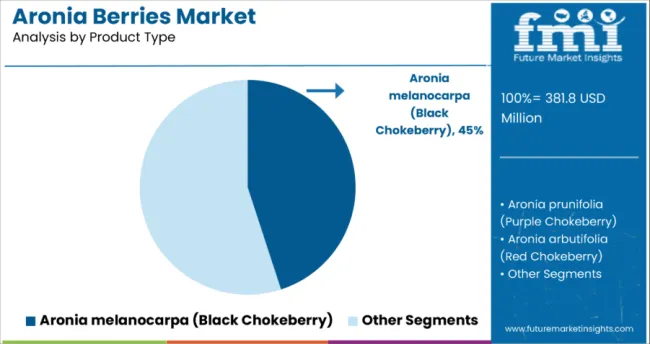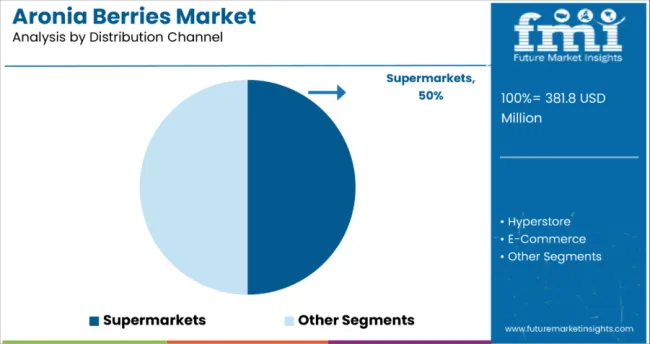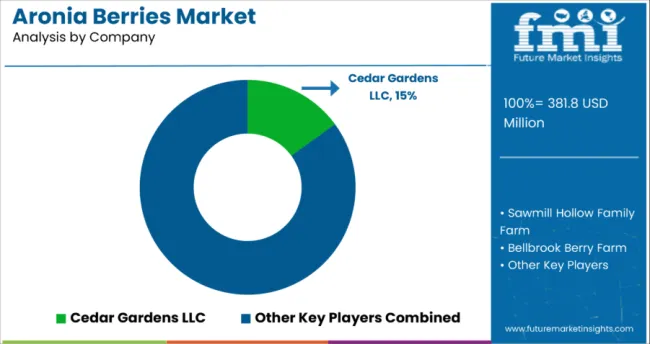The aronia berries market is estimated to be valued at USD 381.8 million in 2025. It is projected to reach USD 533.4 million by 2035, registering a compound annual growth rate (CAGR) of 3.4% over the forecast period. The market is projected to add an absolute dollar opportunity of USD 153.6 million over the forecast period, reflecting a 1.39 times growth.

| Metric | Value |
|---|---|
| Estimated Size (2025E) | USD 381.8 million |
| Projected Value (2035F) | USD 533.4 million |
| CAGR (2025 to 2035) | 3.4% |
The market’s evolution is expected to be shaped by rising demand in the food & beverage and pharmaceutical industries, especially for antioxidant-rich products, dietary supplements, and functional foods that target health-conscious consumers globally.
By 2030, the market is likely to reach approximately USD 447.5 million, accounting for USD 65.7 million in incremental value over the first half of the decade. The remaining USD 87.9 million is expected during the second half, suggesting a moderately back-loaded growth pattern driven by rising adoption of processed aronia berries and nutraceutical formulations worldwide.
Companies such as Cedar Gardens LLC, B.T. Aronia Farm, and Sawmill Hollow Family Farm are strengthening their market positions through product diversification, organic certifications, and value-added processed products. Expansion into juice concentrates, powders, and extracts is supported by strategic partnerships and sustainable farming initiatives. Market performance will continue to be anchored by quality standards, antioxidant content, and compliance with food and pharmaceutical regulations.
The market is part of broader parent markets, including the fruits and vegetables market, nutraceuticals market, functional food market, dietary supplements market, and beverages market. The aronia berries market holds approximately 2.1% of the global fruits and vegetables market, 3.5% of the nutraceuticals market, 1.8% of the functional food market, 2.0% of the dietary supplements market, and 0.5% of the global beverages market. Its contribution to these parent markets continues to grow due to increasing consumer preference for antioxidant-rich and natural health products.
The market is being driven by rising consumer health consciousness and the increasing prevalence of lifestyle diseases. Innovations include juice concentrates, powdered extracts, and functional foods with enhanced antioxidant content. Recent developments involve organic certifications and sustainable farming practices to meet regulatory compliance. Trends indicate a shift toward processed and value-added aronia berry products in food, beverages, and nutraceutical sectors. Market growth is further supported by technological advancements in extraction methods, fortified products, and increased awareness of aronia berries’ cardiovascular, anti-inflammatory, and anti-cancer benefits
Aronia berries are being increasingly recognized for their high antioxidant content, rich polyphenols, and nutritional benefits, making them a preferred ingredient in food, beverages, and dietary supplements. Their functional properties, including cardiovascular support, anti-inflammatory effects, and immune-boosting potential, are driving consumer adoption among health-conscious populations globally.
Rising awareness of superfoods and natural health products is further propelling demand in processed juices, powders, jams, and nutraceutical formulations. The growing prevalence of lifestyle diseases and preventive healthcare trends is encouraging manufacturers to integrate aronia berries into functional foods and supplements.
Sustainability initiatives, organic farming practices, and innovations in extraction and processing techniques are enhancing product quality and accessibility. As consumers increasingly prioritize antioxidant-rich, clean-label ingredients, the Aronia Berries Market is well-positioned for sustained growth across food, beverage, and pharmaceutical applications worldwide.
The aronia berries market is segmented by product type, form, source, distribution channel, and regions. By product type, the market includes aroniaprunifolia (purple chokeberry), aroniaarbutifolia (red chokeberry), and aroniamelanocarpa (black chokeberry). By form, the market is segmented into whole berries and value-added products. By source, the market is divided into organic and conventional. Based on distribution channel, the market is categorized into hyperstore, supermarkets, and e-commerce. Regionally, the market is classified into North America, Latin America, Asia Pacific, Eastern Europe, Western Europe, Japan and MEA.

The aroniamelanocarpa segment dominates the product type category with a 45% share, driven by its high antioxidant content and widespread consumer recognition as a superfood. Its versatility across food, beverage, and supplement applications makes it a preferred choice for manufacturers seeking functional ingredients with proven health benefits.
Processed forms such as juices, powders, and capsules are increasingly used in nutraceuticals, smoothies, fortified beverages, and dietary supplements, enhancing the segment’s relevance. The fruit’s strong anti-inflammatory, cardiovascular, and immune-supporting properties underpin consumer adoption, especially among health-conscious populations in North America and Europe.
Investment in sustainable cultivation, organic certification, and value-added processing technologies is further strengthening the aroniamelanocarpa segment. Companies are focusing on high-yield varieties, standardized extracts, and fortified formulations, positioning this segment as the most lucrative within the product type category over the 2025–2035 forecast period.

Supermarkets lead the distribution channel segment with a 50% market share, driven by extensive accessibility, organized retail infrastructure, and high consumer footfall. Supermarkets provide opportunities for premium aronia berry products, including fresh berries, juices, jams, and powders, to reach a broad audience efficiently.
The channel benefits from brand visibility, promotional campaigns, and consistent supply chains, ensuring the availability of both fresh and processed aronia berry products. Consumer preference for one-stop shopping and organized retail convenience supports higher penetration of functional and health-focused foods, making supermarkets a critical avenue for revenue growth.
Retailers are investing in dedicated organic and functional food sections, loyalty programs, and in-store sampling to boost consumer engagement. With the rising trend of health-conscious purchasing and demand for antioxidant-rich superfoods, the supermarket channel remains the most lucrative and strategically significant segment in the Aronia Berries Market for the 2025–2035 forecast period.
The global aronia berries market has witnessed significant growth due to increasing awareness of antioxidant-rich superfoods and the rising prevalence of lifestyle diseases such as cardiovascular ailments, diabetes, and obesity. In 2025, the market is expected to benefit from expanding applications across food & beverages, dietary supplements, and pharmaceuticals. Manufacturers are introducing value-added products such as juices, powders, extracts, and functional formulations that provide high polyphenol content and immune-boosting properties.
Consumer preference for clean-label, natural ingredients further supports adoption. Investments in sustainable farming, organic certification, and fortified product innovation are contributing to wider availability and enhanced nutritional efficacy, strengthening consumer trust and product penetration across North America, Europe, and Asia-Pacific.
Health-Conscious Consumption and Functional Food Trends Drive Market Expansion
Food and beverage companies are increasingly leveraging aronia berries to deliver antioxidant-rich, functional products. Aronia berry extracts are being incorporated into dietary supplements, fortified beverages, and nutraceutical formulations to improve cardiovascular health, reduce inflammation, and provide natural anti-aging benefits.
Functional foods enriched with aronia berries retain bioactive compounds even after processing, which enhances product value and consumer appeal. Rising demand in ready-to-drink beverages, smoothies, dietary supplements, and fortified snacks is driving revenue growth, particularly in regions with high health awareness. As awareness about preventive healthcare grows, adoption rates of aronia berry-based products are expected to rise steadily.
Supply Chain Challenges, Price Sensitivity, and Processing Limitations Restrict Growth
Despite strong demand, the market faces constraints due to seasonal availability, high cultivation costs, and limited processing infrastructure for standardized extracts and powders. Price fluctuations for premium aronia berry varieties impact both fresh and processed product affordability, particularly in price-sensitive regions.
Processing constraints such as cold chain requirements, extract standardization, and shelf-life maintenance add to production costs and logistics complexity. Limited processing facilities with capacity for high-quality, value-added products restrict large-scale adoption. These challenges moderate growth despite ongoing consumer interest and increasing investment in functional and health-oriented applications.

| Country/Region | CAGR (2025 to 2035) |
| USA | 6.5% |
| Germany | 6.4% |
| France | 6.2% |
| UK | 4.4% |
| Japan | 2.7% |
In the aronia berries market, growth varies across leading countries due to differences in health awareness, functional food adoption, and retail infrastructure. The USA leads with a CAGR of 6.5%, supported by strong food & beverage and dietary supplement demand. Germany follows at 6.4%, driven by clean-label innovation and nutraceutical integration. France shows 6.2% growth, aided by the adoption of premium and artisanal products. The UK has moderate growth at 4.4%, constrained by supply issues, while Japan grows steadily at 2.7%, influenced by aging population trends.
The report covers an in-depth analysis of 40+ countries; five top-performing OECD countries are highlighted below.
The aronia berries market in the USA is projected to grow at a CAGR of 6.5% from 2025 to 2035, driven by increasing consumer preference for antioxidant-rich foods and functional beverages. Widespread adoption in juices, powders, and dietary supplements is boosting market demand. Retail expansion through supermarkets and online platforms enhances accessibility. Investments in high-yield cultivation and standardized processing ensure consistent product quality. North American consumers’ focus on clean-label, natural ingredients further supports Aroniamelanocarpa’s leading role in the market.
Key Statistics:
Sales of aronia berries in Germany are expected to rise at a CAGR of 6.4% from 2025 to 2035, driven by clean-label food trends and nutraceutical adoption. Key regions include Berlin, Hamburg, and Munich, where demand for functional superfoods is high. Manufacturers emphasize organic certification, powdered extracts, and fortified products for food, beverages, and dietary supplements. Collaborative initiatives between Aronia producers and nutraceutical companies are enhancing product innovation, quality, and market penetration. German regulatory frameworks support product standardization and consumer trust.
Key Statistics:
Revenue from aronia berries in France is poised to expand at a CAGR of 6.2% from 2025 to 2035, with growth concentrated in Paris, Lyon, and Bordeaux. Premium and artisanal product integration is driving adoption in juices, powders, and extracts for dietary supplements and functional foods. Regulatory compliance and organic certification enhance market acceptance. Manufacturers are expanding value-added products to meet increasing consumer health demands. Rising awareness of antioxidant-rich superfoods and functional beverages supports market growth across urban and semi-urban regions in France.
Key Statistics:
Demand for aronia berries in the UK is anticipated to increase at a CAGR of 4.4% from 2025 to 2035. Growth is concentrated in London, Manchester, and Edinburgh, driven by the adoption of functional beverages and health-conscious consumption trends. Supply limitations and import dependency slightly constrain expansion. Supermarkets and specialty stores are the primary distribution channels, ensuring product visibility. Consumer preference for natural, antioxidant-rich ingredients is supporting gradual adoption. Investment in supply chain optimization and promotional campaigns is helping maintain steady market growth across the country.
Key Statistics:
The aronia berries market in Japan is projected to grow at a CAGR of 2.7% from 2025 to 2035, reflecting steady but slower adoption. Tokyo, Osaka, and Nagoya are the primary consumption hubs. Functional foods, dietary supplements, and products for the aging population drive growth.
Manufacturers focus on powdered and extract-based products to provide antioxidant-rich, health-oriented options. Consumer demand for clean-label and fortified foods supports market development. At the same time, domestic production and imported Aronia berries together cater to rising functional food trends in Japan’s urban and health-conscious demographics.
Key Statistics:

The aronia berries market is moderately consolidated, comprising a mix of global agricultural producers, specialized berry farms, and regional cultivators with varying expertise in cultivation, processing, and value-added product development. Cedar Gardens LLC and B.T. Aronia Farm are leading players in the market, focusing on large-scale cultivation, processing, and distribution of fresh and processed Aroniamelanocarpa for food, beverage, and nutraceutical applications. Their strength lies in vertically integrated operations, reliable supply chains, and partnerships with functional food manufacturers across North America and Europe.
Sawmill Hollow Family Farm and Bellbrook Berry Farm differentiate through organic certification, small-batch premium production, and specialized extract processing for dietary supplements and functional beverages. Their operations emphasize sustainable cultivation practices, high antioxidant retention, and product traceability, allowing them to capture niche markets in health-conscious and clean-label segments. P.P.H.U. Bio Juice and Microstructure Sp. Focus on value-added products such as juice concentrates, powders, and extracts, catering to functional food, beverage, and nutraceutical applications while leveraging regional distribution networks in Europe and Asia-Pacific.
Regional players, including TECOFOOD sp, Mae’s Health, OPG Medic, and GreenField Sp., emphasize local market penetration, innovation in processing technologies, and product diversification. They are driving growth through antioxidant-rich extracts, fortified beverages, and health supplements. Barriers to entry remain significant due to high-quality cultivation requirements, specialized processing techniques, organic certification standards, and supply chain logistics for perishable berries. Competitiveness increasingly depends on cultivation efficiency, antioxidant concentration retention, product innovation, and distribution partnerships, particularly for fresh and processed Aronia berry applications across food, beverage, and nutraceutical markets.
| Item | Value |
| Quantitative Units (2025) | USD 3 81.8 Million |
| Product Type | Aronia prunifolia (Purple Chokeberry), Aronia arbutifolia (Red Chokeberry), Aronia melanocarpa (Black Chokeberry) |
| Form | Whole berries, Value-added products |
| Source | Organic, Conventional |
| Distribution Channel | Hyperstore, Supermarkets, E-Commerce |
| Regions Covered | North America, Europe, Asia-Pacific, Latin America, Middle East & Africa |
| Country Covered | United States, Canada, United Kingdom, Germany, France, China, Japan, South Korea, Brazil, Australia and 40+ countries |
| Key Companies Profiled | Cedar Gardens LLC, B.T. Aronia Farm, Sawmill Hollow Family Farm, Bellbrook Berry Farm, P.P.H.U. Bio Juice, Microstructure Sp., TECOFOOD Sp., Mae's Health, OPG Medic, GreenField Sp., Wellness |
| Additional Attributes | Dollar sales by application and purity grade, regional demand trends, competitive landscape, consumer preferences for natural versus synthetic alternatives, integration with sustainable sourcing practices, innovations in extraction technology and quality standardization for diverse industrial applications |
The global aronia berries market is estimated to be valued at USD 381.8 million in 2025.
The market size for the aronia berries market is projected to reach USD 533.4 million by 2035.
The aronia berries market is expected to grow at a 3.4% CAGR between 2025 and 2035.
The key product types in aronia berries market are aronia prunifolia (purple chokeberry), aronia arbutifolia (red chokeberry) and aronia melanocarpa (black chokeberry).
In terms of form, whole berries segment to command 58.2% share in the aronia berries market in 2025.






Full Research Suite comprises of:
Market outlook & trends analysis
Interviews & case studies
Strategic recommendations
Vendor profiles & capabilities analysis
5-year forecasts
8 regions and 60+ country-level data splits
Market segment data splits
12 months of continuous data updates
DELIVERED AS:
PDF EXCEL ONLINE
Blueberries Market Analysis – Size, Share & Forecast 2025-2035
Red Berries Market Trends – Growth, Demand & Health Benefits

Thank you!
You will receive an email from our Business Development Manager. Please be sure to check your SPAM/JUNK folder too.
Chat With
MaRIA